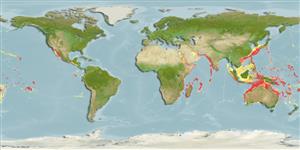Common names from other countries
Classification / Names / Names
Namen | Synonyme | Catalog of Fishes (gen., sp.) | ITIS | CoL | WoRMS
Environment: milieu / climate zone / depth range / distribution range
Ökologie
; brackwasser; tiefenbereich 1 - 701 m (Ref. 96667). Tropical
Indo-Pacific: from Red Sea to Japan and Hawaii.
Length at first maturity / Size / Gewicht / Alter
Maturity: Lm ? range ? - ? cm Max length : 6.7 cm TL (female)
Found on muddy sand with sponges, red mud, coarse muddy shell sand to sand with fragments of coralline algae (Ref. 80410). Species can be found in estuarine or brackish waters, from intertidal to subtidal areas (Ref. 106854).
Life cycle and mating behavior
Geschlechtsreife | Fortpflanzung | Ablaichen | Eier | Fecundity | Larven
Some members of the order Stomatopoda pair for life and some come together only to mate. Males produce sperm ducts rather than spermatophores; females can brood a maximum of 50,000 eggs. Life cycle: Eggs hatch to a planktonic zoea which lasts for 3 months.
Ahyong, S.T. 2001. (Ref. 3099)
IUCN Rote Liste Status (Ref. 130435)
CITES Status (Ref. 108899)
Not Evaluated
Not Evaluated
Bedrohung für Menschen
Harmless
Nutzung durch Menschen
| FishSource |
Tools
Mehr Information
Alter/GrößeWachstumLänge-GewichtLänge-LängeMorphologieLarvenDichte
Internet Quellen
Estimates based on models
Preferred temperature
(Ref.
115969): 11.7 - 26.5, mean 18.6 (based on 573 cells).
